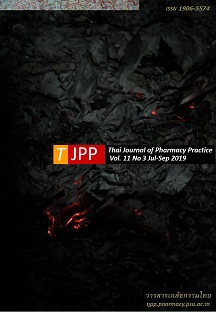ผลของโปรแกรมส่งเสริมสมรรถนะแห่งตนต่อความสามารถในการใช้ยาฉีดอินซูลิน ชนิดปากกาในผู้ป่วยโรคเบาหวานชนิดที่ 2: การทดลองเชิงสุ่มที่มีกลุ่มควบคุม
Main Article Content
บทคัดย่อ
วัตถุประสงค์: เพื่อศึกษาผลของการใช้โปรแกรมส่งเสริมสมรรถนะแห่งตน (self-efficacy enhancing program: SEEP) ต่อความสามารถและความรู้ในการใช้ยาฉีดอินซูลินชนิดปากกา (insulin-penfill injection: IPI) การควบคุมระดับน้ำตาลในเลือด และการรับรู้สมรรถนะแห่งตนในผู้ป่วยโรคเบาหวานชนิดที่ 2 วิธีการ: การศึกษาเป็นการทดลองเชิงสุ่มที่มีกลุ่มควบคุม โดยศึกษาในผู้ป่วยโรคเบาหวานที่เข้ามารับบริการที่คลินิกผู้ป่วยนอก โรงพยาบาลปากพนังที่ใช้ IPI ไม่ถูกต้องอย่างน้อย 1 ขั้นตอนจากทั้งหมด 5 ขั้นตอน มีการใช้ยาฉีดอินซูลินด้วยตนเอง และมีค่า glycosylated hemoglobin (HbA1C) > 7% ผู้ป่วยถูกสุ่มให้อยู่ในกลุ่มศึกษา (n=92) และกลุ่มควบคุม (n=92) กลุ่มศึกษาได้รับ SEEP ทุก 2 เดือน รวมจำนวน 4 ครั้ง กลุ่มควบคุมได้รับการบริการจากฝ่ายเภสัชกรรมตามปกติ ระยะเวลาการศึกษาประมาณ 10 เดือน ผลการวิจัย: ข้อมูลทั่วไปและตัวแปรตามของผู้ป่วยในกลุ่มศึกษาและกลุ่มควบคุมไม่แตกต่างกันอย่างมีนัยสำคัญในช่วงก่อนการแทรกแซง (P>0.05) เมื่อสิ้นสุดการศึกษาพบว่า กลุ่มศึกษามีคะแนนความสามารถในการใช้ IPI (19.93±0.33 จากคะแนนเต็ม 20) มากกว่ากลุ่มควบคุม (13.47±0.70) (P<0.001) คะแนนความรู้ในการใช้ยาฉีดอินซูลินของกลุ่มศึกษามากกว่ากลุ่มควบคุมอย่างมีนัยสำคัญ (8.95±0.27 และ 4.47±0.52 จากคะแนนเต็ม 9 ตามลำดับ; P<0.001) ค่า HbA1C และ FPG (fasting plasma glucose) ของกลุ่มศึกษาต่ำกว่ากลุ่มควบคุมอย่างมีนัยสำคัญ (HbA1C = 6.14±0.29% และ 8.81±1.52% ตามลำดับ; P<0.001 และ FPG = 106.24±12.80 mg/dL และ 176.28±23.46 mg/dL ตามลำดับ; P<0.001) นอกจากนี้คะแนนการรับรู้สมรรถนะแห่งตนต่อการใช้ยาฉีดอินซูลินของกลุ่มศึกษามากกว่ากลุ่มควบคุมอย่างมีนัยสำคัญ (P<0.001) ด้วย สรุป: การใช้ SEEP ทำให้ผู้ป่วยมีความสามารถและความรู้ในการใช้ IPI เพิ่มขึ้น รวมทั้งมีการควบคุมระดับน้ำตาลและการรับรู้สมรรถนะแห่งตนในการใช้ IPI ที่ดีขึ้น ดังนั้นควรสนับสนุนให้มีการใช้ SEEP ในการดูแลผู้ป่วยโรคเบาหวานที่ใช้ยาฉีดอินซูลินต่อไป
Article Details
ผลการวิจัยและความคิดเห็นที่ปรากฏในบทความถือเป็นความคิดเห็นและอยู่ในความรับผิดชอบของผู้นิพนธ์ มิใช่ความเห็นหรือความรับผิดชอบของกองบรรณาธิการ หรือคณะเภสัชศาสตร์ มหาวิทยาลัยสงขลานครินทร์ ทั้งนี้ไม่รวมความผิดพลาดอันเกิดจากการพิมพ์ บทความที่ได้รับการเผยแพร่โดยวารสารเภสัชกรรมไทยถือเป็นสิทธิ์ของวารสารฯ
เอกสารอ้างอิง
2. Diabetes Association of Thailand. Diabetes clinical practice guideline [online]. 2017 [cited Apr 6, 2019]. Available from: www.dmthai.org/attachment s/article /443/guideline-diabetes-care-2017.pdf.
3. American Diabetes Association. Glycemic targets: standards of medical care in diabetes. Diabetes care 2018; 41: S1-159.
4. Doggrell SA, Chan V. Adherence to insulin treatment in diabetes: can it be improved? J Diabetes 2015; 7: 315-21.
5. Michael R. Insulin pens: improving adherence and reducing costs [online]. 2015 [cited Sep 11, 2018]. Available from: www.pharmacytimes.com.
6. Lasalvia P, Barahona-Correa JE, Romero-Alvernia DM, Gil-Tamayo S, Castañeda-Cardona C, Bayona JG, et al. Pen devices for insulin self-administration compared with needle and vial: systematic review of the literature and meta-analysis. J Diabetes Sci Technol 2016; 10: 959-66.
7. Ayyagari R, Wei W, Cheng D, Pan C, Signorovitch J, Wu EQ. Effect of adherence and insulin delivery system on clinical and economic outcomes among patients with type 2 diabetes initiating insulin treatment. Value Health 2015; 18: 198-205.
8. Honebrink AN, Peters CR, Bright DR. Insulin pens vs. vials and syringes: the pharmacist's role in individualizing therapy. Consult Pharm 2011; 26: 491-3.
9. Pozzuoli GM, Laudato M, Barone M, Crisci F, Pozzuoli B. Errors in insulin treatment management and risk of lipohypertrophy. Acta Diabetol 2018; 55: 67-73.
10. Frid AH, Hirsch LJ, Menchior AR, Morel DR, Strauss KW. Worldwide injection technique questionnaire study: injecting complications and the role of the professional. Mayo Clin Proc 2016; 91: 1224-30.
11. Cheen HH, Lim SH, Huang MC, Bee YM, Wee HL. Adherence to premixed insulin in a prefilled pen compared with a vial/syringe in people with diabetes in Singapore. Clin Ther 2014; 36: 1043-53.
12. Rashid N, McCombs JS, Schwartz E. Effect of exenatide, pen insulin, and vial insulin on patient outcomes: a retrospective database analysis of persistence and first-year costs in a commercially insured population. Clin Ther 2012; 34: 1145-58.
13. Cuddihy RM, Borgman SK. Considerations for diabetes: treatment with insulin pen devices. Am J Ther 2013; 20: 694-702.
14. Peyrot M, Perez-Nieves M, Ivanova J, Cao D, Schmerold L, Kalirai S, et al. Correlates of basal insulin persistence among insulin-naïve people with type 2 diabetes: results from a multinational survey. Curr Med Res Opin 2017; 33: 1843-51.
15. Bandura A. Self-efficacy: the exercise of control. New York: W.H. Freeman; 1997.
16. Pharmaceutical Division, Phramongkutklao Hospi- tal. Drug delivery devices and administration tech- niques. Bangkok: Poramut Publishers; 2014.
17. Huang JP, Chen HH, Yeh ML. A comparison of diabetes learning with and without interactive multimedia to improve knowledge, control and self-care among people with diabetes in Taiwan. Public Health Nurs 2009; 26: 317-28.
18. Bhumibhamorn S. Evaluation of pharmaceutical care provision in Muslim diabetes mellitus at Nue Klong Hospital [master thesis]. Songkhla: Prince of Songkla University; 2008.
19. Jittsue A, Sangjam P, Treesak C, Hanlerdrit T. Assessment of knowledge and practice of patients before and after counseling in the use of the reusable insulin pen at Vachiraphuket Hospital. Songkla Med J 2016; 34: 27-37.
20. Vangsri P. The effects of supporting self-efficacy program in nephropathy control for diabetic type 2 patients [master thesis]. Nakhon Pathom: Christian University; 2016.
21. Rittiruang A. The effects of the Noraprayuk exercise program applying self-efficacy and social support on glycosylated hemoglobin levels among older adults with diabetes mellitus type 2 [master thesis]. Chonburi: Burapha University; 2015.
22. Ponrak R. Effects of self-efficacy enhancing program on insulin-penfill injection competency and blood sugar level in elderly with diabetes mellitus [master thesis]. Songkhla: Prince of Songkla University; 2014.
23. Ratanapitak U, Krainueat K, Sriwijitkamol A, Vipawattana C. The effects of a diabetic self-management program on knowledge, behavior and health indexes among people with type 2 diabetes. J Nurs Sci 2013; 31: 7-18.
24. Bastable SB. Essentials of patient education [online]. 2006 [cited Jan 15, 2016]. Available from: journals.lww.com.
25. Somnuek P. The development of teaching and learning innovation by using instructional media for enhancement of learning achievement towards tourism product [online]. 2015 [cited May 6, 2018]. Available from: www.tci-thaijo.org/index.php/jitt/arti cle/view/65737
26. Nualthim L, Hingkanont P, Suntayakorn C, Prachanban P. Effects of encouragement on self efficacy program for self management in blood sugar control behavior of diabetes mellitus patients. J Nurse Health Sci 2014; 8: 115-28.
27. Chanchaisri A. Effects of the self-efficacy program on blood sugar control behavior of diabetes mellitus [master thesis]. Chachoengsao: Rajabhat Rajanagarindra University; 2013.
28. Grassi G, Scuntero P, Trepiccioni R, Marubbi F, Strauss K. Optimizing insulin injection technique and its effect on blood glucose control. J Clin Transl Endocrinol 2014; 1: 145-50.


